On- Duchamp
Notes about the possible Influence of Jules Henri Poincaré on Marcel Duchamp
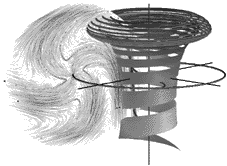
| Influence of Henri Poincaré
on Marcel Duchamp On- Duchamp Notes about the possible Influence of Jules Henri Poincaré on Marcel Duchamp |
 |
|
| Jules Henri Poincaré - a French mathematician from the beginning of the 20th century - published in 1908 an extraordinary essay, "Science et méthode" (Science and Method). In his time Poincaré was considered - relatively - obscure as a scientist and only known to insiders and interested individuals. Today Poincaré is more widely known for his first steps (or pioneering) of the mathematics that has gone into the revolutionary scientific chaos theory. |
| Poincaré’s essay on science
and creativity might have inspired the artist Marcel Duchamp to find other
ways of artistic expression.
Reading documents on creativity "On the dynamics of creativity" By: Ben Goertzel, and many other authors on the subject, I was pointed at Henri Poincaré in relation to creativity. To find out something more about this mathematician and the relation with creativity, I read several extracts and summaries of his work. (It would be too difficult for me to read the complete work or some specific publications) At first I was primarily interested in the link with creativity, a relation
which Poincaré had described in the publication
"Science and Method", but later on there appeared to be a direct
link with the artist Marcel Duchamp, especially with the work "La
marieé mise à nu par ses célibataires, même"
(The bride stripped bare by her bachelors, even).
Linda Henderson and Craig Adcock, art historians at the University of Texas at Austin and resp. the University of Iowa , also wrote about the possible relation Poincaré - Duchamp. Adcock, C. [1984] "Conventionalism in Henri Poincaré and Marcel Duchamp." Art Journal Though I do not fully subscribe to their ideas - Henderson's specifically - there would be evidence that Poincaré had influenced Duchamp in a number of ways. Duchamp’s championing of the artist’s "special intuition" in interpreting the world in a certain extend paved the way for conceptual art. But what were the odds? Poincaré speculates that unconscious processes, between distinctive periods of active thought, continue to associate ideas, bringing fertile combinations to consciousness. Chosen by their aesthetic appeal, a creative mathematician would recognize the sudden whim or EUREKA, which could be the link - if not solution - for his problem. Within the speculation Duchamp was aware of this particular publishing, it could be possible that he decided to use his 'laziness' - periods of existential 'breathing' (i. e. a process of subconscious thinking) - to serve higher levels of creativity. Duchamp had a special interest in the science of that time, the mathematician Riemann for example. In an interview he said: "Naturally, I never read seriously the works of Riemann because I would have been incapable of it" (MD), but he had a very real appreciation for Riemann’s mathematics. It's almost beyond doubt that Poincaré’s essay was known to Duchamp. The avant-garde artists - Duchamp in particular - of that time were keen on scientific and mathematical theory with exotic notions as four-dimensional and non-Euclidean geometries significantly in focus. The work "Marieé" (The Bride) shows evidence of his awareness with Poincaré’s work, the painting of which he claimed to be his first glimpse of the "fourth dimension". The link I see however, is not only aimed towards the possible inspiration through the notions of non-Euclidean geometries, thermodynamics, electricity etc. (which must have been important sources for the notes from the "Green Box"), but mainly towards the unorthodox and special notions of creativity and the role of intuition Poincaré described in a number of publications. |
|
Epicurus's Hooked Atoms: Poincaré's extended Metaphor |
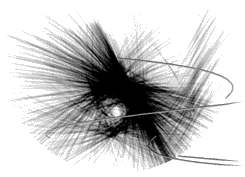 |
| "In the essay "Mathematical Discovery," Poincaré
writes of the stage of creativity, which he calls "illumination," in the
language of 19th century thermodynamics, with reference to Epicurus's hooked
atoms:
during a period of apparent repose, but of unconscious work, some of them are detached from the wall and set in motion. They plough through space in all directions... like the gaseous molecules in the kinetic theory of gases. Their mutual collisions may then produce new combinations. (Science and Method) Poincaré describes habitual thinking as anchored in an inertial frame represented by the spatial metaphor of walls to which thoughts are hooked. He describes liberated thought as the product of entropic processes capable of spontaneous re-orderings once those thoughts are unhooked." "Clearly, Poincaré means to apply these physical references as tropes for thoughts swarming through the boundaries of conceptual systems. While he says that "My comparison is very crude, but I cannot well see how I could explain my thought in any other way" (Science and Method), he expects his readers to take this correspondence seriously. This tactic is especially fascinating since he implies that tropes constitute a linguistic limit to his ability to explain something crucial about his own thinking." "He seems to ascribe to these entropic thought-swarms the capacity to
self-organize in a way that would make the return of those atom-thoughts
to their original positions on the walls impossible. These swarms may
indeed overwhelm their containing structures, may even require the reorganization
of the sedentary structures of the walls themselves." (Martin
E. Rosenberg - Kettering University) Bergson continuously describes the emerging idea as an image: "one point, not so much a vision as a contact, contact furnishes an impulse, this impulse, a movement, a swirling kind of dust taking a particular form, becomes visible to our eyes through what it has collected along its way." (Henri Bergson - The Creative Mind) As such, it isn't in the realm of the verbal, but instead forms as a sort of translucent graphic that emanates from a "dust storm of knowledge". But all of the loose ends and snippets of thought had to be described to the proper mental structure to be applicable to his work. The (hard to visualize) scientific and technical notions of the surrounding world (including mathematics from Poincaré and Riemann for example, but also much less imaginative "machines" such as a coffee mill or chocolate grinder and water wheel) would have helped Duchamp to the visualization of all these notes. (which for the largest part - deliberately - haven't been worked-out in the piece of glass) |
| knowledge by description < > knowledge by acquaintance | 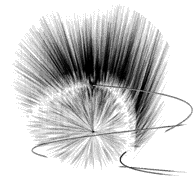 |
I wouldn't want to state Duchamp tried to visualize (and
describe) processes and scientific notions he couldn't understand and appealed
to him in a more poetic and enigmatic fashion, but that he couldn't understand
completely what he was doing: he intuitively followed hunches and acted
upon impulses of various kind, from aesthetic nature to "mediative" and
(pseudo-)scientific and theoretic nature. But he didn't give (and this
makes a big difference) any of the sort of motives (sensations) greater
value or weight than the other.
(which he once called visual / aesthetic indifference, but it is doubtful if he could sufficiently suppress impulses of aesthetic care: Duchamp can tell us: "the choice of these "readymades" was never dictated by aesthetic delectation", or that he suffered from "a reaction of visual indifference with at the same time a total absence of good or bad taste... in fact a complete anaesthesia" - it helps, but it's not conclusive. If Duchamp was gifted in a visual creative manner, can he ignore impulses? He can react; might suspend - "delay" - them and challenge his self-control - the faculty to sublimate must have been one of his extraordinary characteristics)In this way he might have considered thoughts as "ready made"; "which can be accepted or reprobated by (the) draught" (MD in relation to the three "draft pistons", in the uppermost part of the glass) This draught could be the spiritual "wind", which connected him to the "fourth dimension". Within this process of (re-)internalizing (both ideas, notions and objects) he tried to preserve the state in which "it came to him" as much as possible. This is why the form he chose to multiply the original "Green Box", was so meticulously carried out: "The limited edition of ninety-four notes, drawings, and photographs, printed in facsimile, using the same papers and the same inks or pencil leads, torn or snipped in precisely the same way as the originals, with the same crossings-out and corrections and abbreviations and unfinished thoughts" (Calvin Tomkins)The "Green Box" had to maintain it's original appearance and thereby he - probably subconsciously - considered himself the mediumistic being he referred to later in his life (after more - or a different - insight). He did not allow "himself" to decide (especially at later stages) what shape the working-out of thoughts had to take and relied on the original fashion (in fact chained combinations and associations) in which he first - intuitively - described / visualized his considerations with it. |
|
| Duchamp also wouldn't allow himself to repeat earlier concepts
or building on ideas outside the frame of a series of chained combinations,
presenting a distinctive work, but he continued to add material to existing
work (such as "The bride stripped bare", even after the issuing of the
"Green Box"). This process (with open end: so it can't be completed really)
could also be described as "meta-creativity",
opening endless possibilities to new combinations, not only to the artist,
but - by its nature - also to the spectator, who can be actively engaged
with the sheer endless associations. Part of the work of art would be done
by the public in this view.
"---The creative act is not performed by the artist alone; the spectator brings the work in contact with the external world by deciphering and interpreting its inner qualifications and thus adds his (her) contribution to the creative act---." (MD) The fact Duchamp didn't talk to much about his motives and that he didn't care to explain his work, could be related to the manner in which his creativity revealed itself and became manifest in his work. "Verbal learning physically affects and detracts from intuitive thinking". According to Laura Spinney, putting words to information will actually prevent the mind from being able to non consciously access that information again. In her article, she quoted a researcher who studied this particular effect, "verbalization has a very specific effect, it impairs judgement based on intuition." Within the brain, when certain areas related to vision are activated by a task, the focused electrical signals move outwards as multiple possibilities emerge. If the verbal area of the brain is suddenly activated, it actually impedes this expansion because it employs the prefrontal cortex, known for shutting down other brain electrical activity." (Laura Spinney - "I had a Hunch...." New Scientist 1998) Intuition and sensation are pattern recognition processes. The difference is that sensation focuses on the content of an in- or ex- ternal experience. Intuition focuses on the precursors of an experience or where an experience might lead. Descartes stated that sensory perception is not important to knowledge and intuition and that the intellect was the source of information. Immanuel Kant, on the other hand, introduced two types of intuition, sensory and pure. Sensory intuition had two pure forms that created a priori knowledge, space, which underlay all outer intuitions, and time, which underlay inner ones. Pure intuition, however, "unaided by the sense and moreover, constituting the very possibility of sense experiences, is for Kant the source of all synthetic a priori judgements." For Kant, intuition was transcendental, beyond reason and mundane experience. (Paul Budnik - Einstein's Revenge 1995) |
 |
But the act of creation wasn't the only concern of Duchamp |
|
As part of his work, Duchamp created fictional, quasi-scientific
systems that he worked into his visual designs. Calling these playful
systems "pataphysics", he used current scientific thinking of the time
in a satiric way, making fun of rational, determinist systems and celebrating
interesting new developments that cast doubt on traditional thinking. This breaking down of assumptions concerning the
predictable, rational behaviour of the world in Duchamp’s work and in the
sciences share traits with the Dada movement. Rebelling against the rationalist
social structures responsible for the devastating war, Dadaists attempted
to create new languages for artistic (or even anti-artistic) expression.
The Dada movement recognized the inadequacies of existing forms of expression
to compass a real understanding of the changing world, and sought to destroy
all rationalistic cultural norms in art. By satirizing, mimicking, and
distorting the systems they attack, the Dadaists prove the inadequacies
of their targets and point the way to the possibility of better forms.
In a way, the Dada movement acted as a sort of social resistor, slowing
down the cultural machinery of the time, helping to re-orient everyone
in a different direction.
"Poincaré's attitude toward the non-Euclidean geometries --- was that they were just as valid constructs for solving certain kinds of problems as the more traditional Euclidean descriptions that had been perceived to be eternal and unshakeable for over two centuries. He felt that scientific theories are only conventions used by scientists to describe the patterns they see in nature." (Pata or Quantum: Duchamp and the End of Determinist Physics - Jonathan Williams) Poincaré was in certain aspects the kindred spirit of Duchamp, especially in his views of personal / intellectual freedom and was - like Duchamp - a true individualist. |
Anarchic Discipline Jules Henri Poincare
[trans•••]
|
Such texts and statements Poincaré frequently produced,
probably had a strong appeal to Duchamp.
"What he (Duchamp) was interested in above all was freedom - complete personal and intellectual and artistic freedom". (Calvin Tomkins)What in many cases must have been inventions of words to Marcel Duchamp, he could take it on trust from Poincaré. Not the authority of the scientist however, but through the sympathetic appeal of it. (in a certain way closely related to experiences of easthetics) |
| "contemplative
nous" with that it becomes correlate self-moving psyche in respect of numbers (time, number, astronomy) is motion correlate with space |
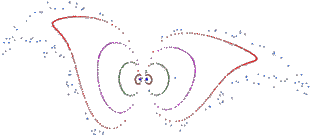
time touches movement matter primary |
| Jules Henri Poincare [trans•••] |
| Homo Universalis
Concluding with the idea that it probably had not been the scientific merits of the theory of Poincaré which could have been appealing to Duchamp - partly because it was such a specialist matter, only fully comprehensible to progressive mathematicians and naturally because Duchamp said about the publications of Riemann "he never read it seriously because he would have been incapable to fully understand it" - but that it had been the particular attitude of Poincaré towards science and thinking in general (freedom), while the theory of course was very challenging, exciting and imagianitive, also to the average interested layman. The inspiration derived from the publication(s) of Poincaré had been one of creative theoretical nature and intuitively Duchamp got the sense of a new and radically different way of thinking: a fundamental shock in a common view of the world. The result of the inspiration was a radically different approach to creativity. Though Duchamp in fact coupled a conventional (classic) world view (Adcock) to the fantasy of a - from a to science still largely unexplored domain - extrasensory dimension, which is only logical and unavoidable, in the end it became a fundamentally different approach to art. Metaphors and classical imaginative mechanisms are from time immemorial the only means to treat particular advanced conceptions in a more general way. With this "translation" in fact part of the content gets mystified, even actually incorrect reproduced, which always has been cause of anxiety to scientists, but without this way of spreading - or rather "widen" - of insights, no matter how crooked sometimes, science would have been isolated from society and would have been deprived through the lack of a broad social basis. One could say that Duchamp mystified - viewed from a scientist - the ideas of Poincaré, but if he did, he did this out of pseudo-morphological scientific, poetic and aesthetic motives. He tried to place the "work of art" in an other dimension, but it had been merely a "hunch": an approximation. A tactic to test if there would be some point in the question whether Duchamp actually incorporated the very merits of science in his work and what it would mean if he did, is to turn the question around: if we would ask a scientist to give a definition of a work of art which would be in proportion to the scientific insights acquired in the 20th century, than the conclusion must be - provided that the particular scientist is as sensible as we would expect him to be - that it isn't the competence of (hard-)science to define what art is or that the secretion of works of art isn't his cup of tea (we didn't ask, but implied it in the question) Of course, in art and science, mutual inspiration could arise from ideas and the common joint of creativity, which is from time immemorial too, but lets face it: art and science are disciplines, specializations. |
| Art is - in social context - almost fundamentally different
from science. The typical conditions, demanding and comprehensive, are
such, that within the limitation of a single lifetime, a coupling of art
and science in equal depth and practise must be considered virtually impossible.
Although the idea of the "Homo Universalis", which became a matter of common knowledge through the work of Leonardo Da Vinci, of course stirs the imagination, in the work of Da Vinci as well as Duchamp however, the "brewing of ideas" in potential and an unmistakable expressive skill and craftsmanship, but none the less the raw non-elaborated and impracticable ideas - often unfinished, sometimes impossible - represent a very different practise than the one of argumentation and practical - reproducible - working models, as is the case with science. The common factor is one of a philosophical creative nature (ARTIS), but the comparison in social context (the working out and appliance of ideas) wouldn't have the slightest similarity, just because art and science are (or since the renaissance became) really different specializations. |
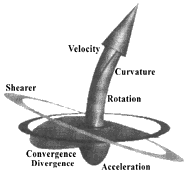 |
| Fiction or facts
Apart from the conclusions Linda Henderson and Craig Adcock reached in their publications, I'm not standing alone in the opinion that Henri Poincaré - specifically the publication "Science and Method" - could have been important to Duchamp. Recently a very active and informative source on the WEB about this relation has been esthablished by Rhonda Roland Shearer - who even organized a symposium about the subject, but unfortunately - in my view - got a bit carried away with it. Shearer and her team present a lot of amazing (preliminary) findings though... Shearer directs the Art Science Research Laboratory in New York City, which is devoted to the scientific study of Duchamp's art. In November 1999, she hosted a symposium at Harvard called "Methods of Understanding in Art and Science: The Case of Duchamp and Poincaré."We must not forget that the similarities between the notes of the Green Box and the visual work-outs on the Large Glass and the work of Poincaré could be for the greater part -even entirely - fictional, just as with the example of Herman Melville's "The Paradise of Bachelors and the Tartarus of Maids" of 1852, which describes a bizarre world that comprises of nine bachelors and a gigantic machine. This machine is operated by "freezing" virgins and it produces "some sort of spermatozoid liquid from old clothes" Jean Suquet, Miroir de la Mariée, Paris 1973. Jean Suquet pointed out that the narration constitutes a counterpart to the "Bachelor Machine" of the Large Glass. Both agree even in details such as names and numbers, even though it is almost certain that Duchamp had never read Melville. |
|
N.B. - This short text about "the possible Influence of Jules Henri Poincaré on Marcel Duchamp" is not exhaustive and it is certainly by no means an attempt to be scientifically correct. (I'm no art historian, nor scientist) It simply expands on the ideas and direction of ABANDON, while various opinions and ideas expressed here are subjective. |
| |
. |
| . | • Stichting Abandon • p/a Josephstraat 97-B • 3014 TL Rotterdam • Netherlands • Europe • |